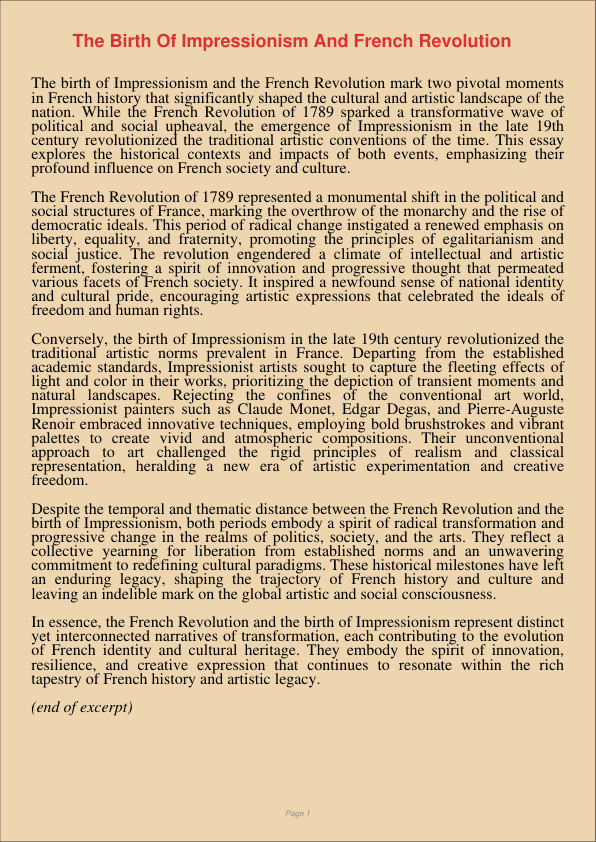The Birth Of Impressionism And French Revolution
Jan 12, 2024
french revolution
impressionism
Marketing
English
The birth of Impressionism and the French Revolution mark two pivotal moments in French history that significantly shaped the cultural and artistic landscape of the nation. While the French Revolution of 1789 sparked a transformative wave of political and social upheaval, the emergence of Impressionism in the late 19th century revolutionized the traditional artistic conventions of the time. This essay explores the historical contexts and impacts of both events, emphasizing their profound influence on French society and culture.
The French Revolution of 1789 represented a monumental shift in the political and social structures of France, marking the overthrow of the monarchy and the rise of democratic ideals. This period of radical change instigated a renewed emphasis on liberty, equality, and fraternity, promoting the principles of egalitarianism and social justice. The revolution engendered a climate of intellectual and artistic ferment, fostering a spirit of innovation and progressive thought that permeated various facets of French society. It inspired a newfound sense of national identity and cultural pride, encouraging artistic expressions that celebrated the ideals of freedom and human rights.
Conversely, the birth of Impressionism in the late 19th century revolutionized the traditional artistic norms prevalent in France. Departing from the established academic standards, Impressionist artists sought to capture the fleeting effects of light and color in their works, prioritizing the depiction of transient moments and natural landscapes. Rejecting the confines of the conventional art world, Impressionist painters such as Claude Monet, Edgar Degas, and Pierre-Auguste Renoir embraced innovative techniques, employing bold brushstrokes and vibrant palettes to create vivid and atmospheric compositions. Their unconventional approach to art challenged the rigid principles of realism and classical representation, heralding a new era of artistic experimentation and creative freedom.
Despite the temporal and thematic distance between the French Revolution and the birth of Impressionism, both periods embody a spirit of radical transformation and progressive change in the realms of politics, society, and the arts. They reflect a collective yearning for liberation from established norms and an unwavering commitment to redefining cultural paradigms. These historical milestones have left an enduring legacy, shaping the trajectory of French history and culture and leaving an indelible mark on the global artistic and social consciousness.
In essence, the French Revolution and the birth of Impressionism represent distinct yet interconnected narratives of transformation, each contributing to the evolution of French identity and cultural heritage. They embody the spirit of innovation, resilience, and creative expression that continues to resonate within the rich tapestry of French history and artistic legacy.
